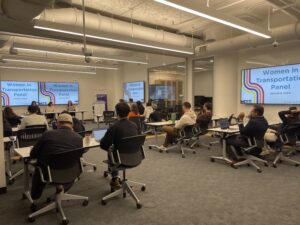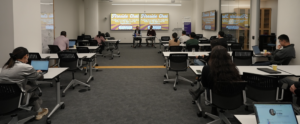LinkedIn LinkedIn LinkedIn Meet 2023-24’s Women in Transportation The Women...
Read MoreOn February 24, 2022, the U.S. Department of Transportation (USDOT) hosted a video forum featurin the latest innovative research in artificial intelligence (AI) in transportation from University Transportation Centers (UTCs) across the country. The webinar featured the research of 11 UTCs, including C2SMART, showcasing their USDOT-funded AI research and its potential impact on society.
Videos addressed issues of national importance such as distracted driving, pedestrian safety, and traffic mitigation. C2SMART’s entry showcased our work in Big Data in Smart Cities via our COVID-19 Data dashboard and our Safety in Transportation Systems research area through innovative use of VR in roadway workzones.

All road construction sites have safety measures: a combination of signage, warning systems, and alerts are meant to help both drivers and workers navigate the shared roadway as maintenance and upgrading projects take place. Despite this, between 2018 and 2019, worker fatalities in road construction sites increased by 7.4% across all types of roadways, representing 16.2% of all work zone related fatalities. This increase is happening despite only a modest increase in construction spending and a 2% overall decrease of fatal crashes outside of work zones.
Smarter alert and advanced-warning systems are necessary, but live-testing these systems can be costly and time-consuming, while also putting both roadway workers and drivers at risk. Researchers at the C2SMART Center, led by Dr. Semiha Ergan, have taken an innovative approach to alleviating this problem, building a cyberphysical testbed populated with real-world data to explore worker behavior, using artifical-intelligence and machine learning to adapt and improve notification alerts for safer work zones.
This type of testing, and the adaptive response of the notification system, has huge implications for the future of worker safety. Conducting tests in a VR environment avoids the issue of endangering workers with live-site tests, and the AI techniques open doors for individualized alert systems, enabling the development of a notification system that is tailored to not just broad behaviors, but individual response.
Additionally, one of the most innovative and timely research efforts led by Drs. Kaan Ozbay and Jingqin Gao, was in using artificial intelligence methods to develop a deep-learning object detection method to use live video feeds from public traffic cameras to determine pedestrian and traffic volumes and see densities on city streets and sidewalks. This effort has allowed C2SMART researchers to track and evaluate, in real time, the effects of COVID-19 policies on urban travel behavior and mobility trends across NYC.
Related Posts
6th Annual Women in Transportation Panel
March 11, 2024 To celebrate Women’s History Month, C2SMARTER, the...
Read MoreCUNY City Tech/NYU C2SMARTER Poster Presentation & Social
March 5, 2024 In early March, C2SMARTER’s NYU contingent hosted...
Read MoreStudent Learning Hub: Fireside Chat with Chris Wichman of Airsage
February 21, 2024 On Wednesday, February 21, C2SMARTER hosted a...
Read More



